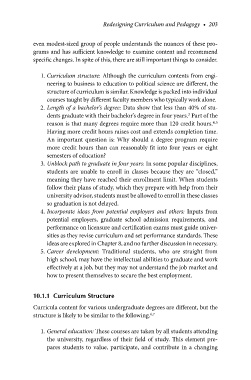Page 232 - Crisis in Higher Education
P. 232
Redesigning Curriculum and Pedagogy • 203
even modest-sized group of people understands the nuances of these pro-
grams and has sufficient knowledge to examine content and recommend
specific changes. In spite of this, there are still important things to consider.
1. Curriculum structure: Although the curriculum contents from engi-
neering to business to education to political science are different, the
structure of curriculum is similar. Knowledge is packed into individual
courses taught by different faculty members who typically work alone.
2. Length of a bachelor’s degree: Data show that less than 40% of stu-
3
dents graduate with their bachelor’s degree in four years. Part of the
reason is that many degrees require more than 120 credit hours.
4,5
Having more credit hours raises cost and extends completion time.
An important question is: Why should a degree program require
more credit hours than can reasonably fit into four years or eight
semesters of education?
3. Unblock path to graduate in four years: In some popular disciplines,
students are unable to enroll in classes because they are “closed,”
meaning they have reached their enrollment limit. When students
follow their plans of study, which they prepare with help from their
university advisor, students must be allowed to enroll in these classes
so graduation is not delayed.
4. Incorporate ideas from potential employers and others: Inputs from
potential employers, graduate school admission requirements, and
performance on licensure and certification exams must guide univer-
sities as they revise curriculum and set performance standards. These
ideas are explored in Chapter 8, and no further discussion in necessary.
5. Career development: Traditional students, who are straight from
high school, may have the intellectual abilities to graduate and work
effectively at a job, but they may not understand the job market and
how to present themselves to secure the best employment.
10.1.1 Curriculum Structure
Curricula content for various undergraduate degrees are different, but the
structure is likely to be similar to the following. 6,7
1. General education: These courses are taken by all students attending
the university, regardless of their field of study. This element pre-
pares students to value, participate, and contribute in a changing

